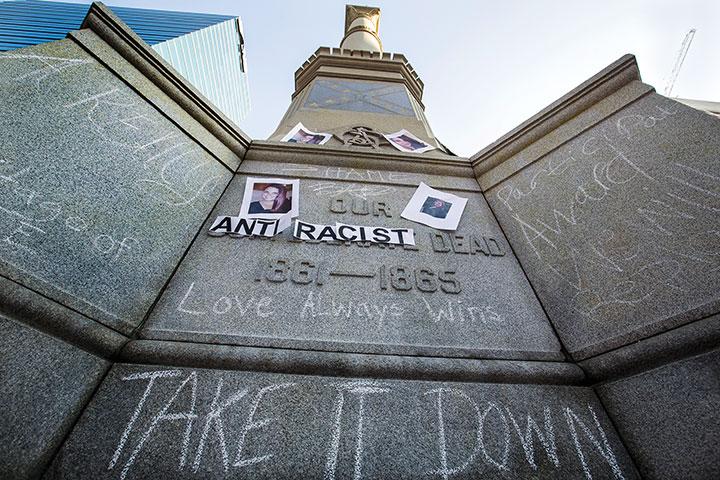
Tera W. Hunter is a professor of history and African American studies at Princeton. Her latest book is Bound in Wedlock: Slave and Free Black Marriage in the Nineteenth Century (Belknap Press of Harvard University Press, 2017).
In December 1865, the College of New Jersey, as Princeton was known, created an honor roll of students and alumni who died during the Civil War, which had ended several months before. Understandably, only those who served in the Union Army were identified. At a memorial service sponsored by College trustees at the First Presbyterian Church six months later, the Rev. Joseph Duryea, the officiating pastor, took pains to valorize only the soldiers who fought for the United States. Yes, he noted, there were those who served with “disloyal States” in the “insurgent army,” but the two sides would not and should not be treated as morally equivalent. One army fought to restore the United States; the other sought to destroy it.
Fast forward to the 1920s, when a longer list of deceased students and alumni who served in the Civil War was carved into the marble wall in the atrium of Nassau Hall. At the insistence of President John Grier Hibben 1882, the son of a Civil War soldier who died serving the Union, the names were listed alphabetically without identifying which army each soldier fought for. The gesture to neutralize the enmity among brothers literally hid the fact that more Princetonians actually fought on the side of the breakaway Confederate States of America, not for the United States. Of the 86 who died as a result of the conflict, 48 fought with the rebels and 38 with the Union. These alliances reflected the College’s longstanding ties to the South and its sympathies for the institution of slavery, which the Princeton & Slavery Project has documented.
It was startling to learn that in 1924, the National Alumni Association of Princeton University donated $1,000 to the Confederate Monument Association to support the completion of what is now Stone Mountain. The larger-than-life granite carvings of leading secessionists Jefferson Davis, Stonewall Jackson, and Robert E. Lee are most infamously known as the site of the founding of the second Ku Klux Klan (KKK) in 1915, near Atlanta. Members of the United Daughters of the Confederacy (UDC) led the campaign to raise funds to enshrine the site as a symbol of white supremacy, which was part of their larger effort to vindicate their ancestors.
Both the creation of the memorial wall and the alumni donation marked significant departures in tone and substance from Princeton’s initial memorialization of the Civil War, honoring only the dead soldiers of the United States. What transpired in the intervening years? A national political, economic, and cultural reckoning helps to explain the revived controversy about Civil War monuments today.
White Southerners began honoring the rebel military just after the war ended, and there have been unrelenting efforts to do so ever since. But there were two crucial periods in which the majority of the Confederate monuments were built, a fact that’s essential to understanding their contentious historical roles and what should be done about them.
The first period was between 1895 and the 1920s, as Southern states enacted Jim Crow (segregationist) laws and disenfranchised black citizens, the KKK revived its violent white-supremacist campaign, and most lynchings of black people occurred. The second period coincided with the start of the modern civil-rights movement in the 1950s and 1960s, as an overt backlash to the extension of American democracy to African American citizens.
A 2016 report by the Southern Poverty Law Center found that there are more than 1,500 symbols of the Confederacy in public places, although the number is slowly shrinking in response to recent outbreaks of violence by white supremacists. They include the names of Confederates on parks, trails, and public schools (many of which have large African American student populations), the flying of the Confederate flag, the identification of official state holidays and observances in honor of insurgents, and the building of monuments and statues in the likeness of famed leaders (overwhelmingly on courthouse grounds). The message of the monuments has been crystal clear. Confederate figures lording over the institutions charged with enforcing universal law meant that African Americans should enter into them knowing they would be subjected to white rule.
Confederate symbols have appeared in odd places on private property, such as stained-glass windows installed in the Washington National Cathedral (of the Episcopal Church) in 1953, lionizing the likes of Lee and Jackson. The separation of church and state could not have been more blurred, until events in August in Charlottesville, Va., in which a neo-Nazi and KKK rally led to the death of Heather Heyer, inspired their removal.
Oddest of all, Confederate symbols adorn federal property. There are 10 major U.S. military bases named after disloyal men who waged war against the nation and slaughtered loyal citizens. There are monuments to rebel leaders in the National Statuary Hall of Congress mounted between 1909 and 1929. There are images of the battle flag contained in state flags that fly in the House complex. The Gettysburg National Military Park in Pennsylvania has marble and granite monuments valorizing insurgent combatants all over its grounds.
Perhaps most egregious, there is a Confederate monument in Arlington National Cemetery, commemorating not only the soldiers who died fighting against the Union, but also featuring an enslaved man following his master into battle and an enslaved woman described as “mammy” cuddling a white child. [The monument was dedicated in 1914 on Jefferson Davis’ birthday.] That emblems of white nationalism have been widely abided by the federal government indicates just how normalized they have been.
The majority of these symbols are located in the South. But a striking number are located all over the country, from New York to California, and in several states that did not exist at the time of the Civil War, such as Arizona, Idaho, and Montana. Their proliferation can be attributed partly to the “Great Migration” of white Southerners to other states. But credit as the leading purveyor of Confederate statuary goes largely to the UDC for its unmitigated early- to mid-20th-century campaign. It masterfully perpetuated the mythology of the “Lost Cause” by educating generations to see the Civil War in retrospect as a noble fight for “states’ rights,” to diminish the role that slavery played in the conflict, to reinvent slavery as a benevolent institution, and to literally whitewash unfavorable historical facts. White Northerners were complicit in donating funds and lending moral support to these efforts, or they remained silent while Confederate markers cluttered public landscapes nearly everywhere.
Defenders of Confederate monuments have been fond of asserting that they represent “heritage, not hate.” Local chapters of the KKK donated money to build some of them. The messages delivered in speeches at the times they were dedicated and the inscriptions on many of the monuments themselves are unmistakable in their bigotry and embrace of the “Lost Cause.” A monument in Charlotte, N.C., erected in 1929, praises Confederate soldiers because “they preserved the Anglo Saxon civilization of the South.” It was defaced in 2015 and subsequently put in a clear protective case to prevent future vandalism.
Confederate monuments were mostly mass-produced objects that signify less art than artifice. As historian Fitzhugh Brundage has stated, they are “the result of private groups colonizing public space.” They were allowed to flourish to foster reconciliation between white Southerners and Northerners after Reconstruction was toppled, to heal the nation’s wounds sundered by the bloodiest war in our history. They did so at particular times when white supremacy was ascendant and African Americans fought back for civil rights.
The monuments do not memorialize a truthful history of the Civil War, even from the perspective of the South. Nowhere are the Southerners who fought for the United States — mostly black and enslaved — represented. Nowhere are the minority of white Southerners who dissented and allied with the Union ever honored in marble or stone. Nowhere are the war’s emancipatory achievements represented. All that remains are artifacts of intolerance that inspired their erection in the first place.
“We must never forget that victory to the rebellion meant death to the republic,” Frederick Douglass reminded the crowd on Decoration Day at Arlington National Cemetery in 1871. “We must never forget that the loyal soldiers who rest beneath this sod flung themselves between the nation and the nation’s destroyers.” As Princetonians in 1865 insisted, treason and disloyalty to the United States should not be rewarded in idol worship and public displays.

